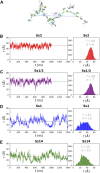Comparative Molecular Modelling of Capsular Polysaccharide Conformations in Streptococcus suis Serotypes 1, 2, 1/2 and 14 Identifies Common Epitopes for Antibody Binding
- PMID: 35211512
- PMCID: PMC8861514
- DOI: 10.3389/fmolb.2022.830854
Comparative Molecular Modelling of Capsular Polysaccharide Conformations in Streptococcus suis Serotypes 1, 2, 1/2 and 14 Identifies Common Epitopes for Antibody Binding
Abstract
Streptococcus suis is an encapsulated, commensal, potentially pathogenic bacterium that infects swine globally and causes sporadic life-threatening zoonotic septicemia and meningitis infections in humans. The capsular polysaccharide is a primary virulence factor for S. suis. As S. suis serotype 2 is the most prevalent serotype globally, the serotype 2 CPS is the primary target of current efforts to develop an effective glycoconjugate veterinary vaccine against S. suis. Possible cross-protection with related serotypes would broaden the coverage of a vaccine. The CPS in serotypes 2 and 1/2 differ at a single residue (Gal versus GalNAc), and both are similar to serotypes 1 and 14: all contain a terminal sialic acid on a side chain. However, despite this similarity, there is complex pattern of cross-protection for these serotypes, with varying estimations of the importance of sialic acid in a protective epitope. Further, a pentasaccharide without the terminal sialic acid has been identified as minimal epitope for serotype 2. Here we use molecular simulation to model the molecule conformations of the CPS in serotypes 2, 1/2, 1 and 14, as well as three vaccine candidate oligosaccharides. The common epitopes we identify assist in rationalizing the apparently contradictory immunological data and provide a basis for rational design of S. suis vaccines in the future.
Keywords: Streptococcus suis; antigen; capsular polysaccharide; carbohydrate epitopes; conformation; cross protection; molecular modelling and simulation.
Copyright © 2022 Kuttel.
Conflict of interest statement
The author declares that the research was conducted in the absence of any commercial or financial relationships that could be construed as a potential conflict of interest.
Figures





Similar articles
-
Explaining the Serological Characteristics of Streptococcus suis Serotypes 1 and 1/2 from Their Capsular Polysaccharide Structure and Biosynthesis.J Biol Chem. 2016 Apr 15;291(16):8387-98. doi: 10.1074/jbc.M115.700716. Epub 2016 Feb 24. J Biol Chem. 2016. PMID: 26912653 Free PMC article.
-
Capsular Sialyltransferase Specificity Mediates Different Phenotypes in Streptococcus suis and Group B Streptococcus.Front Microbiol. 2018 Apr 3;9:545. doi: 10.3389/fmicb.2018.00545. eCollection 2018. Front Microbiol. 2018. PMID: 29666608 Free PMC article.
-
Comparative Study of Immunogenic Properties of Purified Capsular Polysaccharides from Streptococcus suis Serotypes 3, 7, 8, and 9: the Serotype 3 Polysaccharide Induces an Opsonizing IgG Response.Infect Immun. 2020 Sep 18;88(10):e00377-20. doi: 10.1128/IAI.00377-20. Print 2020 Sep 18. Infect Immun. 2020. PMID: 32747605 Free PMC article.
-
Characterization and Protective Activity of Monoclonal Antibodies Directed against Streptococcus suis Serotype 2 Capsular Polysaccharide Obtained Using a Glycoconjugate.Pathogens. 2019 Sep 7;8(3):139. doi: 10.3390/pathogens8030139. Pathogens. 2019. PMID: 31500262 Free PMC article.
-
Streptococcus suis vaccines: candidate antigens and progress.Expert Rev Vaccines. 2015;14(12):1587-608. doi: 10.1586/14760584.2015.1101349. Epub 2015 Oct 15. Expert Rev Vaccines. 2015. PMID: 26468755 Review.
Cited by
-
Identification of SepF in Streptococcus suis involving cell division.BMC Microbiol. 2025 Mar 31;25(1):179. doi: 10.1186/s12866-025-03919-3. BMC Microbiol. 2025. PMID: 40165076 Free PMC article.
-
Modeling of pneumococcal serogroup 10 capsular polysaccharide molecular conformations provides insight into epitopes and observed cross-reactivity.Front Mol Biosci. 2022 Aug 8;9:961532. doi: 10.3389/fmolb.2022.961532. eCollection 2022. Front Mol Biosci. 2022. PMID: 36003080 Free PMC article.
-
AI-2 quorum sensing-induced galactose metabolism activation in Streptococcus suis enhances capsular polysaccharide-associated virulence.Vet Res. 2024 Jun 17;55(1):80. doi: 10.1186/s13567-024-01335-5. Vet Res. 2024. PMID: 38886823 Free PMC article.
References
-
- Auger J.-P., Dolbec D., Roy D., Segura M., Gottschalk M. (2018). Role of the Streptococcus Suis Serotype 2 Capsular Polysaccharide in the Interactions with Dendritic Cells Is Strain-dependent but Remains Critical for Virulence. PLoS ONE 13 (7), e0200453. 10.1371/journal.pone.0200453 - DOI - PMC - PubMed
-
- Calzas C., Taillardet M., Fourati I. S., Roy D., Gottschalk M., Soudeyns H., et al. (2017). Evaluation of the Immunomodulatory Properties of Streptococcus Suis and Group B Streptococcus Capsular Polysaccharides on the Humoral Response. Pathogens 6 (2), 16. 10.3390/pathogens6020016 - DOI - PMC - PubMed
LinkOut - more resources
Full Text Sources
Research Materials
Miscellaneous

